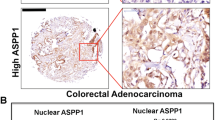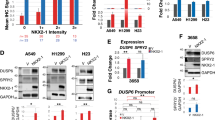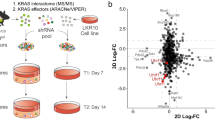Abstract
The four R-spondins (RSPO1–4) and their three related receptors LGR4, 5 and 6 (LGR4–6) have emerged as a major ligand-receptor system with critical roles in development and stem cell survival through modulation of Wnt signaling. Recurrent, gain-of-expression gene fusions of RSPO2 (to EIF3E) and RSPO3 (to PTPRK) occur in a subset of human colorectal cancer. However, the exact roles and mechanisms of the RSPO-LGR system in oncogenesis remain largely unknown. We found that RSPO3 is aberrantly expressed at high levels in approximately half of Keap1-mutated lung adenocarcinomas (ADs). This high RSPO3 expression is driven by a combination of demethylation of its own promoter region and deficiency in Keap1 instead of gene fusion as in colon cancer. Patients with RSPO3-high tumors (~9%, 36/412) displayed much poorer survival than the rest of the cohort (median survival of 28 vs 163 months, log-rank test P<0.0001). Knockdown (KD) of RSPO3, LGR4 or their signaling mediator IQGAP1 in lung cancer cell lines with Keap1 deficiency and high RSPO3-LGR4 expression led to reduction in cell proliferation and migration in vitro, and KD of LGR4 or IQGAP1 resulted in decrease in tumor growth and metastasis in vivo. These findings suggest that aberrant RSPO3-LGR4 signaling potentially acts as a driving mechanism in the aggressiveness of Keap1-deficient lung ADs.
This is a preview of subscription content, access via your institution
Access options
Subscribe to this journal
Receive 50 print issues and online access
$259.00 per year
only $5.18 per issue
Buy this article
- Purchase on Springer Link
- Instant access to full article PDF
Prices may be subject to local taxes which are calculated during checkout





Similar content being viewed by others
References
de Lau WB, Snel B, Clevers HC . The R-spondin protein family. Genome Biol 2012; 13: 242.
Bell SM, Schreiner CM, Wert SE, Mucenski ML, Scott WJ, Whitsett JA . R-spondin 2 is required for normal laryngeal-tracheal, lung and limb morphogenesis. Development 2008; 135: 1049–1058.
Yamada W, Nagao K, Horikoshi K, Fujikura A, Ikeda E, Inagaki Y et al. Craniofacial malformation in R-spondin2 knockout mice. Biochem Biophys Res Commun 2009; 381: 453–458.
Carmon KS, Gong X, Lin Q, Thomas A, Liu Q . R-spondins function as ligands of the orphan receptors LGR4 and LGR5 to regulate Wnt/beta-catenin signaling. Proc Natl Acad Sci USA 2011; 108: 11452–11457.
de Lau W, Barker N, Low TY, Koo BK, Li VS, Teunissen H et al. Lgr5 homologues associate with Wnt receptors and mediate R-spondin signalling. Nature 2011; 476: 293–297.
Glinka A, Dolde C, Kirsch N, Huang YL, Kazanskaya O, Ingelfinger D et al. LGR4 and LGR5 are R-spondin receptors mediating Wnt/beta-catenin and Wnt/PCP signalling. EMBO Rep 2011; 12: 1055–1061.
McDonald T, Wang R, Bailey W, Xie G, Chen F, Caskey CT et al. Identification and cloning of an orphan G protein-coupled receptor of the glycoprotein hormone receptor subfamily. Biochem Biophys Res Commun 1998; 247: 266–270.
Hsu SY, Kudo M, Chen T, Nakabayashi K, Bhalla A, van der Spek PJ et al. The three subfamilies of leucine-rich repeat-containing G protein-coupled receptors (LGR): identification of LGR6 and LGR7 and the signaling mechanism for LGR7. Mol Endocrinol 2000; 14: 1257–1271.
Hsu SY, Liang SG, Hsueh AJ . Characterization of two LGR genes homologous to gonadotropin and thyrotropin receptors with extracellular leucine-rich repeats and a G protein-coupled, seven-transmembrane region. Mol Endocrinol 1998; 12: 1830–1845.
Hao HX, Xie Y, Zhang Y, Charlat O, Oster E, Avello M et al. ZNRF3 promotes Wnt receptor turnover in an R-spondin-sensitive manner. Nature 2012; 485: 195–200.
Carmon KS, Gong X, Yi J, Thomas A, Liu Q . RSPO-LGR4 functions via IQGAP1 to potentiate Wnt signaling. Proc Natl Acad Sci USA 2014; 111: E1221–E1229.
Noritake J, Watanabe T, Sato K, Wang S, Kaibuchi K . IQGAP1: a key regulator of adhesion and migration. J Cell Sci 2005; 118: 2085–2092.
White CD, Erdemir HH, Sacks DB . IQGAP1 and its binding proteins control diverse biological functions. Cell Signal 2012; 24: 826–834.
Seshagiri S, Stawiski EW, Durinck S, Modrusan Z, Storm EE, Conboy CB et al. Recurrent R-spondin fusions in colon cancer. Nature 2012; 488: 660–664.
Lowther W, Wiley K, Smith GH, Callahan R . A new common integration site, Int7, for the mouse mammary tumor virus in mouse mammary tumors identifies a gene whose product has furin-like and thrombospondin-like sequences. J Virol 2005; 79: 10093–10096.
Theodorou V, Kimm MA, Boer M, Wessels L, Theelen W, Jonkers J et al. MMTV insertional mutagenesis identifies genes, gene families and pathways involved in mammary cancer. Nat Genet 2007; 39: 759–769.
Starr TK, Allaei R, Silverstein KA, Staggs RA, Sarver AL, Bergemann TL et al. A transposon-based genetic screen in mice identifies genes altered in colorectal cancer. Science 2009; 323: 1747–1750.
Weng J, Luo J, Cheng X, Jin C, Zhou X, Qu J et al. Deletion of G protein-coupled receptor 48 leads to ocular anterior segment dysgenesis (ASD) through down-regulation of Pitx2. Proc Natl Acad Sci USA 2008; 105: 6081–6086.
Mendive F, Laurent P, Van Schoore G, Skarnes W, Pochet R, Vassart G . Defective postnatal development of the male reproductive tract in LGR4 knockout mice. Dev Biol 2006; 290: 421–434.
Kato S, Matsubara M, Matsuo T, Mohri Y, Kazama I, Hatano R et al. Leucine-rich repeat-containing G protein-coupled receptor-4 (LGR4, Gpr48) is essential for renal development in mice. Nephron Exp Nephrol 2006; 104: e63–e75.
Gugger M, White R, Song S, Waser B, Cescato R, Riviere P et al. GPR87 is an overexpressed G-protein coupled receptor in squamous cell carcinoma of the lung. Dis Markers 2008; 24: 41–50.
Gao J, Aksoy BA, Dogrusoz U, Dresdner G, Gross B, Sumer SO et al. Integrative analysis of complex cancer genomics and clinical profiles using the cBioPortal. Sci Signal 2013; 6: pl1.
Li B, Dewey CN . RSEM: accurate transcript quantification from RNA-Seq data with or without a reference genome. BMC Bioinformatics 2011; 12: 323.
Barretina J, Caponigro G, Stransky N, Venkatesan K, Margolin AA, Kim S et al. The Cancer Cell Line Encyclopedia enables predictive modelling of anticancer drug sensitivity. Nature 2012; 483: 603–607.
Yi J, Xiong W, Gong X, Bellister S, Ellis LM, Liu Q . Analysis of LGR4 receptor distribution in human and mouse tissues. PLoS ONE 2013; 8: e78144.
Bild AH, Yao G, Chang JT, Wang Q, Potti A, Chasse D et al. Oncogenic pathway signatures in human cancers as a guide to targeted therapies. Nature 2006; 439: 353–357.
Okayama H, Kohno T, Ishii Y, Shimada Y, Shiraishi K, Iwakawa R et al. Identification of genes upregulated in ALK-positive and EGFR/KRAS/ALK-negative lung adenocarcinomas. Cancer Res 2012; 72: 100–111.
Network TCGA. Comprehensive molecular characterization of human colon and rectal cancer. Nature 2012; 487: 330–337.
Singh A, Misra V, Thimmulappa RK, Lee H, Ames S, Hoque MO et al. Dysfunctional KEAP1-NRF2 interaction in non-small-cell lung cancer. PLoS Med 2006; 3: e420.
Hayes JD, McMahon M . NRF2 and KEAP1 mutations: permanent activation of an adaptive response in cancer. Trends Biochem Sci 2009; 34: 176–188.
Imielinski M, Berger AH, Hammerman PS, Hernandez B, Pugh TJ, Hodis E et al. Mapping the hallmarks of lung adenocarcinoma with massively parallel sequencing. Cell 2012; 150: 1107–1120.
Solis LM, Behrens C, Dong W, Suraokar M, Ozburn NC, Moran CA et al. Nrf2 and Keap1 abnormalities in non-small cell lung carcinoma and association with clinicopathologic features. Clin Cancer Res 2010; 16: 3743–3753.
Takahashi T, Sonobe M, Menju T, Nakayama E, Mino N, Iwakiri S et al. Mutations in Keap1 are a potential prognostic factor in resected non-small cell lung cancer. J Surg Oncol 2010; 101: 500–506.
Singh A, Happel C, Manna SK, Acquaah-Mensah G, Carrerero J, Kumar S et al. Transcription factor NRF2 regulates miR-1 and miR-206 to drive tumorigenesis. J Clin Invest 2013; 123: 2921–2934.
Malhotra D, Portales-Casamar E, Singh A, Srivastava S, Arenillas D, Happel C et al. Global mapping of binding sites for Nrf2 identifies novel targets in cell survival response through ChIP-Seq profiling and network analysis. Nucleic Acids Res 2010; 38: 5718–5734.
Ke N, Wang X, Xu X, Abassi YA . The xCELLigence system for real-time and label-free monitoring of cell viability. Methods Mol Biol 2011; 740: 33–43.
Johnson M, Sharma M, Henderson BR . IQGAP1 regulation and roles in cancer. Cell Signal 2009; 21: 1471–1478.
Thiery JP, Acloque H, Huang RY, Nieto MA . Epithelial-mesenchymal transitions in development and disease. Cell 2009; 139: 871–890.
Jenkins DE, Oei Y, Hornig YS, Yu SF, Dusich J, Purchio T et al. Bioluminescent imaging (BLI) to improve and refine traditional murine models of tumor growth and metastasis. Clin Exp Metastasis 2003; 20: 733–744.
Kandoth C, McLellan MD, Vandin F, Ye K, Niu B, Lu C et al. Mutational landscape and significance across 12 major cancer types. Nature 2013; 502: 333–339.
Lawrence MS, Stojanov P, Mermel CH, Robinson JT, Garraway LA, Golub TR et al. Discovery and saturation analysis of cancer genes across 21 tumour types. Nature 2014; 505: 495–501.
Mazieres J, He B, You L, Xu Z, Jablons DM . Wnt signaling in lung cancer. Cancer Lett 2005; 222: 1–10.
Shinmura K, Kahyo T, Kato H, Igarashi H, Matsuura S, Nakamura S et al. RSPO fusion transcripts in colorectal cancer in Japanese population. Mol Biol Rep 2014; 41 (8): 5375–5384.
Nam JS, Turcotte TJ, Yoon JK . Dynamic expression of R-spondin family genes in mouse development. Gene Expr Patterns 2007; 7: 306–312.
Gattelli A, Zimberlin MN, Meiss RP, Castilla LH, Kordon EC . Selection of early-occurring mutations dictates hormone-independent progression in mouse mammary tumor lines. J Virol 2006; 80: 11409–11415.
Nguyen DX, Chiang AC, Zhang XH, Kim JY, Kris MG, Ladanyi M et al. WNT/TCF signaling through LEF1 and HOXB9 mediates lung adenocarcinoma metastasis. Cell 2009; 138: 51–62.
Pacheco-Pinedo EC, Durham AC, Stewart KM, Goss AM, Lu MM, Demayo FJ et al. Wnt/beta-catenin signaling accelerates mouse lung tumorigenesis by imposing an embryonic distal progenitor phenotype on lung epithelium. J Clin Invest 2011; 121: 1935–1945.
Chien AJ, Conrad WH, Moon RT . A Wnt survival guide: from flies to human disease. J Invest Dermatol 2009; 129: 1614–1627.
Hayashi H, Nabeshima K, Aoki M, Hamasaki M, Enatsu S, Yamauchi Y et al. Overexpression of IQGAP1 in advanced colorectal cancer correlates with poor prognosis-critical role in tumor invasion. Int J Cancer 2010; 126: 2563–2574.
Liu Y, Lin D, Xiao T, Ma Y, Hu Z, Zheng H et al. An immunohistochemical analysis-based decision tree model for estimating the risk of lymphatic metastasis in pN0 squamous cell carcinomas of the lung. Histopathology 2011; 59: 882–891.
Miyoshi T, Shirakusa T, Ishikawa Y, Iwasaki A, Shiraishi T, Makimoto Y et al. Possible mechanism of metastasis in lung adenocarcinomas with a micropapillary pattern. Pathol Int 2005; 55: 419–424.
Fujita PA, Rhead B, Zweig AS, Hinrichs AS, Karolchik D, Cline MS et al. The UCSC Genome Browser database: update 2011. Nucleic Acids Res 2011; 39: D876–D882.
Kim D, Salzberg SL . TopHat-Fusion: an algorithm for discovery of novel fusion transcripts. Genome Biol 2011; 12: R72.
Furukawa M, Xiong Y . BTB protein Keap1 targets antioxidant transcription factor Nrf2 for ubiquitination by the Cullin 3-Roc1 ligase. Mol Cell Biol 2005; 25: 162–171.
Nakatani Y, Ogryzko V . Immunoaffinity purification of mammalian protein complexes. Methods Enzymol 2003; 370: 430–444.
Acknowledgements
We thank TCGA for generating the genomics data, collecting the clinical information and making them available for analysis. We also thank cBioportal for providing data analysis and visualization tools and downloading capability. We thank Dr B Fang at the University of Texas MD Anderson Cancer for the cell lines A549, H460 and H2009 cells. This work was supported in part by the Cancer Prevention and Research Institute of Texas (CPRIT, RP100678), the US National Institute of Health-NIH (R01GM102485), the Texas Emerging Technology Fund and the Janice D. Gordon endowment for bowel cancer research (to QJL), by NIH (R00LM009837, TL1TR000371) and CPRIT (R1006; to JTC) and by the Texas Emerging Technology Fund (to ZA).
Author information
Authors and Affiliations
Corresponding author
Ethics declarations
Competing interests
The authors declare no conflict of interest.
Additional information
Supplementary Information accompanies this paper on the Oncogene website
Supplementary information
Rights and permissions
About this article
Cite this article
Gong, X., Yi, J., Carmon, K. et al. Aberrant RSPO3-LGR4 signaling in Keap1-deficient lung adenocarcinomas promotes tumor aggressiveness. Oncogene 34, 4692–4701 (2015). https://doi.org/10.1038/onc.2014.417
Received:
Revised:
Accepted:
Published:
Issue Date:
DOI: https://doi.org/10.1038/onc.2014.417
This article is cited by
-
LGR4 and LGR5 form distinct homodimers that only LGR4 complexes with RNF43/ZNRF3 to provide high affinity binding of R-spondin ligands
Scientific Reports (2023)
-
Computing microRNA-gene interaction networks in pan-cancer using miRDriver
Scientific Reports (2022)
-
The role of R-spondin proteins in cancer biology
Oncogene (2021)
-
RSPO3 is a prognostic biomarker and mediator of invasiveness in prostate cancer
Journal of Translational Medicine (2019)
-
Inhibitory Effect of MiR-449b on Cancer Cell Growth and Invasion through LGR4 in Non-Small-Cell Lung Carcinoma
Current Medical Science (2018)



